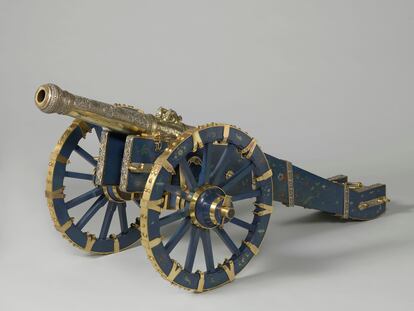The Netherlands has returned 288 pieces of its cultural heritage to Indonesia that were seized during the colonial era. These include four Hindu Buddhist statues brought from Java in the 19th century, and 284 objects such as coins, jewellery, textiles and weapons, which arrived in 1906 after the war against local rulers in Bali. This is the second time that the Dutch Ministry of Culture has responded to a similar request from the Indonesian government, and the return has been approved by the Commission for Colonial Collections. The objects are expected to arrive at their destination in early October.
According to Eppo Bruins, the Dutch Minister of Culture, “these are pieces that should never have entered the Netherlands.” During the colonial period, “looting, pillaging and other forms of involuntary loss of cultural objects were frequent,” he said, explaining the return. He considers it “a matter of justice.” The handover took place last Friday at the Wereldmuseum (Museum of World Cultures) in Amsterdam, which kept them in its collection. The statues come from the 13th-century Singorasi temple. The rest come from the Puputan Badung collection in southern Bali. The Dutch Commission is now studying the case of art taken from Nigeria and India, and new requests from Indonesia and Sri Lanka.
France, Germany and Belgium have studied their colonial collections and returned works. In 2023, the Arts Council of the United Kingdom commissioned a report on restitution and repatriation that was a guide for museums. While it advocated “transparency, collaboration and equity”, there is no official policy on permanent returns by national centres. For its part, the Spanish Ministry of Culture has promoted the formation of two committees of experts to analyse not so much the pieces exhibited at the Museum of America and the Museum of Anthropology, but the discourse of these two art centres. It is part of a process of “review of state collections”, in the words of Minister Ernest Urtasun, delivered on 22 January in Congress.
Under Dutch policy on colonial art of dubious provenance, the return can only take place if the country in question requests it. The origin of the objects is then examined to determine whether they were removed – in this case from Indonesia – by force. With this information in hand, and if there is reasonable certainty that the loss was involuntary, the Commission for Colonial Collections advises the government. Made up of four members who remain in office for a maximum of four years – although they can be re-elected for a similar period – they are appointed by the Minister of Culture. The current chair is Lilian Gonçalves-Ho Kang You, a jurist who has been a State Councillor. Her colleagues are two experts in ethics and museum studies, and in colonial and world history. They are accompanied by a professor of colonial and postcolonial history and cultural history. In the case of the 288 pieces, their recommendations have resulted from close dialogue and cooperation with the Indonesian Repatriation Committee.
In July 2023, the Netherlands returned to Indonesia and Sri Lanka a batch of 478 cultural works that had been unjustly placed in Dutch museums under duress. The collection included the Indonesian Lombok Treasure, made up of jewellery, and the Pita Maha collection, with 132 works of modern art from Bali. The Sri Lankan Kandy cannon, decorated in gold, silver and bronze with ruby inlays, also returned. Its return “fills in the missing part of the national historical narrative,” said Hilmar Farid, director general of the Indonesian Ministry of Culture. For Lilian Gonçalves-Ho Kang You, this marked the beginning of “a new relationship and a shared future” to rectify a historical injustice “through ethical, rather than legal, considerations related to the colonial past.”
Indonesia and the Netherlands have long had ties to each other since the 16th century, when trade began. The Dutch East India Company (VOC) was founded in 1602 and ruled the region until the 18th century. After its dissolution, the Dutch East Indies came under colonial rule. Japan occupied present-day Indonesia in 1942, and after World War II, the Netherlands attempted to restore colonial control. “It met with much resistance and a war of independence followed. In 1949, the Dutch government recognised Indonesia as an independent republic,” according to the National Archives in The Hague.

